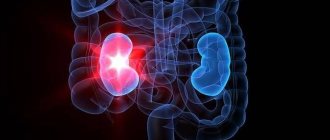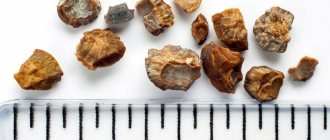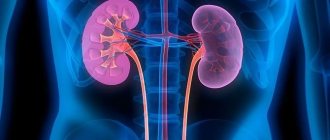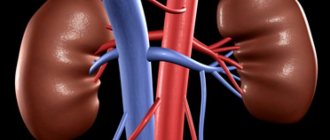To the famous phrase: “a time to scatter stones and a time to gather stones,” one would like to add: “and a time to cast out stones.” From places where they don't belong. There are many cavities in the human body that can become a container for “nuggets.” The kidneys, urinary and gall bladders are simply the most famous of them, but there are others, for example, the pancreatic ducts and even - who would have thought! – a stone may form in the salivary gland! Stones form on teeth; lime is deposited in the lungs and in the wall of the largest blood artery, the aorta, and prickly aggregations of uric acid crystals are deposited in the soft tissues near the joints.
Stones in the kidneys
Most often, stones form in the kidneys. Their sizes can vary from 1 millimeter to 15 centimeters. They can consist of various types of salts and even cholesterol, although this option is much less common. The appearance and characteristics of formations directly depend on their composition.
- Uric acid salts (urate) produce brown stones with a smooth surface and dense.
- From salts of oxalic acid (oxalate) dark crystals are formed, having a lumpy shape with an abundance of spines and processes, very hard. They occur more often in men than in women.
- Salts of amino acid (cystine) form white flat stones, layered and quite soft in consistency.
- Formations from magnesium salts and calcium phosphate (phosphate) are gray in color, their surface can be either smooth or rough. The stones are soft and grow quickly, appearing more often in women than in men.
- Cholesterol stones are black and crumbly.
Stones can settle in any corner of our body. Do you want to know where malicious “guests” can be found and how to deal with them?
Stones in the kidneys
This is a ticking time bomb. You can live for years with kidney stones and not suspect their existence, until one far from wonderful moment they manifest themselves with an attack of renal colic.
Kidney stones can range in size from 0.1 to 15 cm. In world medicine, there are cases when kidney stones reached 2.5 kg!
The composition of kidney stones is:
- urates are smooth, dense brown stones consisting of uric acid salts,
- oxalate - dark and very hard, with many spines and processes, lumpy, formed from oxalic acid salts, more common in men,
- phosphate - gray, smooth or rough, very soft and rapidly expanding. They consist of salts of phosphoric acid calcium or magnesium. Found more often in women.
- cystine - rather soft formations of white color, layered and flattened, consisting of amino acid salts.
- cholesterol stones are black, coal-like, easily crumbling stones. Very rarely found.
Causes of kidney stones
There are many versions on this score: a violation of the acid-base balance of the body, increased urine concentration, hereditary predisposition, unhealthy diet, inflammatory processes in the kidneys.
Treatment of kidney stones
Small pebbles come out on their own, large ones require crushing or surgery. If urates have settled in the body, they can be dissolved with special medications.
Gallstones
The second organ after the kidneys in which stones most often form is the gallbladder. 20% of women and 8% of men over the age of 40 suffer from gallstone disease. These pebbles are also treacherous. They may not bother you for many years and manifest themselves in the form of sudden biliary colic, which can put a person on the operating table. In this case, the stones are removed along with the gallbladder. Their size reaches from 0.1 to 2-3 cm, since the size of the gallbladder is small and enlarging stones immediately manifest themselves.
Gallstones are:
- cholesterol stones are easily crumbled, smooth, often oblong-shaped, black stones.
- pigmented - very soft, without outgrowths and thorns, greenish in color.
The causes of gallstones formation are:
- biliary tract infection,
- hereditary predisposition,
- high-calorie foods with high cholesterol content,
- the presence of female hormones in the body (including hormones contained in hormonal contraceptives). This is why women are more likely to suffer from gallstones.
Treatment of cholelithiasis
Most often, surgical intervention is suggested. It is advisable to perform the operation during a “quiet” period, when the gallbladder is not inflamed. There are also methods for dissolving stones, but, unfortunately, they are not always effective.
Stones in the eyes
They vary in size from hundredths of a millimeter to 0.2-0.3 cm. They are formed as a result of an inflammatory process in the iris and ciliary body (iridocyclitis). Cellular enzymes, dead tissue and pus settle on the back surface of the cornea. Precipitates are formed from them - grayish-white eye stones. Usually there are several such stones, they are arranged in a triangle, the apex of this triangle is directed towards the pupil.
Treatment of eye stones
Eye stones usually resolve over time, so no treatment is prescribed. But sometimes they can persist for years.
Stones in the intestines
These are treacherous stones. Their effect on the body is very similar to ordinary constipation. A person takes laxatives, but does not get the desired effect. Pain appears, the stomach is bursting, uncontrollable vomiting occurs, and in the end, this can lead to surgery. The size of stones in the intestines is from 1 to 6 cm. The causes of their occurrence are dry food, a lack of raw vegetables rich in fiber in the menu, and long-term chronic constipation.
You can remove or dissolve existing stones and prevent new ones from appearing with the help of regular enemas. Avoid constipation to avoid intestinal stones.
Stones in the arteries
Stones can also form in blood vessels, the density of which is not inferior to gravel. Flat stones of yellowish-white color, ranging in size from 0.1 to 5 cm, consisting of salts of fatty acids, line the walls of blood vessels. Fatty foods, a sedentary lifestyle, and smoking contribute to the appearance of cholesterol plaques, which attach to the walls of blood vessels from the inside and damage them. An ulcer appears at this place and calcium begins to be deposited on it, forming stones.
There is no cure for calcium plaques. You can only prevent their occurrence by leading a healthy lifestyle: go on an anti-cholesterol diet, play sports, quit smoking.
Stones in the prostate
The prostate is a place quite vulnerable to the formation of stones. They are formed from protein, amino acids, calcium and dead tissue. Gray-white stones reach sizes from 0.1 to 1 cm. The reason for their appearance is frequent prostatitis and irregular sex life. Stagnant prostate secretions clog areas of the gland, and a stone appears in these places after a few years.
Stones can be dissolved with the help of physiotherapy and enzyme preparations. For treatment to be effective, it is necessary to simultaneously treat the inflammatory process - prostatitis, which usually accompanies the formation of stones.
Stones in the salivary glands
Miniature whitish pebbles, ranging in size from 0.1 to 0.5 cm, resemble a spindle. They are formed from epithelial cells, protein elements, and amino acid salts. The reason for the formation of stones in the salivary glands is disturbances in the outflow and stagnation of secretions in the parotid salivary gland. Inflammation or injury can also lead to stone formation. Stones are removed surgically.
Stones in the ureter
Stones leaving the kidneys travel through the ureter into the bladder. Some may linger and remain in the ureter, growing over time. Moreover, they can grow significantly: doctors have found stones up to 19 cm long! Treatment is the same as for kidney stones: surgery or crushing.
Bladder stones
Stones can enter the bladder from the kidneys, or they can originate locally. More often, stones occur in men as a result of inflammation of the bladder or disturbances in the outflow of urine. In women, stones in the bladder are very rare, since when they appear, they come out with urine. In men, the “path out” for stones is long and tortuous, so medical intervention is necessary.
Share on social media networks
RќСЂР°РІРёС‚СЃСЏ
Causes and symptoms of kidney stones
- Poor nutrition (eating a lot of spicy foods, low fluid intake).
- Hereditary predisposition.
- Lack or excess of vitamins.
- Violation of acid-base balance
- Metabolic disease
- Chronic kidney inflammation
- Increased urine concentration.
Kidney stones can be quiet for quite a long time and not make their presence known.
Then the patient begins to experience pain - this is the most common manifestation of this disease. The pain can be dull, which intensifies with movements or changes in body position, or acute, in which case it either subsides or flares up with renewed vigor. This is the so-called renal colic, which can last for several days. If the stone has migrated to the ureter, the location of the pain changes. After a painful attack, the urine becomes cloudy and contains blood.
Sometimes there is an increase in temperature up to 40 degrees Celsius, which usually indicates the addition of an infection and the development of pyelonephritis.
It is impossible to treat the disease on your own. Without treatment, the stones increase in size and symptoms become more pronounced. Therefore, at the slightest suspicion, you need to contact a specialist who will help you choose the right treatment.
Types of granite
There is a variety of information about granite on the Internet, the most widely known is the Chappell/White . The letter system proposed by Chappell & White initially divided natural stone into I-type (produced by eruption) and S-type (sedimentary), with later types M (from crystallized mafic magmas) and A (created under anogenic conditions) being added.
According to the mineral composition, granite stone is divided into types:
There are a huge number of different types of granite, they are divided by color and deposit, and by structure they are divided into porphyritic and pegmatoid types. The pattern of granite is practically not repeated, which indicates the uniqueness of the stone, and this is a big plus in its use as a building material.
Stones in the ureters
Stones migrate to the ureters from the kidneys and are no different in composition from kidney stones. More often they move to the lowest parts of the urinary system, but sometimes they get stuck, in which case they can only be eliminated through medical intervention.
Symptoms of stones in the ureters:
- acute pain, which is localized in the lumbar region on the affected side and in the groin;
- short-term increase in temperature;
- in some cases, nausea and vomiting occur;
- If there is a complete blockage of the lumen of the ureter with stones, the outflow of urine is disrupted, which in the most severe cases leads to the development of acute renal failure.
Long-term presence of stones in the ureter contributes to the development of fistulas, hydronephrosis and obstructive pyelonephritis. If this happens, the clinical picture will be supplemented by symptoms of these diseases. To avoid serious complications, including life-threatening ones, you do not need to endure pain or self-medicate. It is necessary to contact a urologist as soon as possible.
Nasal cavities
Mineral deposits in the nose are called rhinoliths. As a rule, they form in the lower part of the nasal passage. A feature of rhinoliths is the presence of a foreign object (nucleus), around which the salts contained in the secretion of the mucous membrane are concentrated. Sand particles, fruit seeds, cereal grains and even blood clots can act as nuclei. Rhinolith can remain in the nasal cavity for years. Sometimes the organic core has time to dissolve - in this case the stone looks like a hollow sphere.
Signs of rhinolitis: difficulty in nasal breathing and periodic purulent mucous discharge from the nasal passages.
Causes and symptoms of deposits in the bladder
- Impaired urine flow, which may be caused by obstruction at levels below the bladder (eg, prostate adenoma).
- Neurogenic dysfunction.
- Migration of kidney stones.
- Inflammatory processes in the bladder.
- Presence of foreign bodies (eg, suture material, catheters, mechanical contraceptives).
- History of reconstructive surgery performed to treat incontinence.
- Bladder prolapse in women.
You can find out that there are stones in the bladder by the following signs:
- pain in the lower abdomen and pubic area;
- painful and frequent urge to urinate, including at night;
- blood in the urine, usually in the last portion;
- sometimes a sudden cessation of urination with the appearance of pain in the genital area;
- in some cases, painful erection.
Since these symptoms can also occur with other diseases, only a doctor can make a correct and timely diagnosis.
Magic properties
The mineral is characterized by magical properties. It helps people explore the world and maintain physical and psychological health. The black color made the mineral popular among magicians and sorcerers.
The magical properties of the mineral have been known since ancient times. Indian and African shamans used it to create amulets. It was believed that they provide reliable protection against dark forces. In ancient Rome, the stone was used to make sleep more sound.
The abilities of the mineral were used by sorcerers and people who tried to fight them. There was an opinion that the stone helps eliminate the accumulation of negative energy. An amulet made of black tourmaline is able to protect its owner from curses, envy or damage. It also helps avoid the evil eye.
In addition, with the help of the mineral it is possible to achieve the following effects:
- Increase self-esteem in men and make them more attractive.
- Attract money and good luck in business. The stone provides support to investors, helping them invest money correctly.
- Neutralize harmful radiation from various devices.
- Focus on your goals. To do this, the stone must be kept on the work table.
- Coping with anger and increased anxiety. With the help of the stone you can become much more positive.
The mineral is recommended to be carried by people who return home late or must be in crowded places. This is an excellent assistant for analysts and forecasters.
To cope with negative energy, you can hang a tourmaline amulet in the hallway. The mineral also helps to develop supernatural abilities. With its help, it is possible to coordinate human rhythms with the vibrations of the planets. This is useful for people who like to travel to new places.
Important! Interaction with the stone is not suitable for every person - it must have significant energy potential. Children should not use the mineral.
Causes and symptoms of gallstones
- Hereditary predisposition.
- Poor diet, which includes significant amounts of fatty foods, as well as foods containing high amounts of cholesterol.
- Chronic biliary tract infection.
- Excessive amounts of female sex hormones, in particular those that come with oral contraceptives.
- Frequent childbirth.
- Sharp weight loss.
- Obesity.
- Use of certain drugs, such as cyclosporine or clofebrate.
- Some chronic diseases, including diabetes mellitus, hemolytic anemia, Crohn's disease and some others.
Patients are bothered by attacks of pain. If the stones pass through the bile duct into the intestines, the pain will stop on its own. If they get stuck, the pain syndrome persists and can vary in severity from quite mild to very intense. In addition, it is possible:
- nausea, vomiting;
- bitterness in the mouth, belching with bitter air;
- bloating;
- jaundice due to blockage of the bile duct.
Treatment can be either conservative or surgical. The earlier it is started, the greater the chance of avoiding surgery. Therapy is prescribed exclusively by a doctor.
Medicinal properties
The gem has many healing properties. Even in ancient times, it was used in eastern countries as a healing agent. Tourmaline helps cope with stressful situations, strengthens the immune system and improves tone.
Black tourmaline is a stone that is perfect for athletes. With its help, it is possible to endure physical activity and restore strength. The gem also helps to get rid of alcohol and drug addiction. However, it will only work if the patient wants to be cured.
This crystal should be worn by men as it helps improve potency. The gem is capable of emitting infrared rays. Thanks to this, it dilates blood vessels. Therefore, the mineral is often used to normalize blood pressure, improve cell function and stimulate metabolism.
Sherl should be worn in the midst of epidemics of viral infections. It helps the body fight such diseases.
The black mineral has a beneficial effect on the environment. With its help, it is possible to clean the air from dust and dangerous impurities. To breathe clean air all the time, it is recommended to wear a bracelet or other jewelry with a sherl.
The stone perfectly cleanses the body of waste and toxins. This is very important for people who want to lose excess weight. To do this, it is enough to drink the water in which the stone was lying. It is recommended to put it in a glass of water at night, and drink the composition on an empty stomach in the morning.
Stones in the intestines
Stones in the intestines are called coprolites and appear quite often. Their size can reach 1-6 centimeters. They are formed from undigested food debris that accumulate in the folds of the intestines and begin to rot, becoming compacted under the influence of bacteria.
The reasons for the deposition of stones in the intestines can be: chronic constipation, regular dry food, low consumption of raw vegetables.
If there are stones in the intestines, the patient experiences pain and bloating in the abdomen, bad breath, and skin rashes. Possible obesity, allergies, and in women, disruptions in the menstrual cycle.
Timely treatment of constipation under the supervision of a specialist is necessary. Advanced disease can lead to surgical treatment.
Lungs and bronchi
Lung stones are diagnosed much more often in the female than in the male half of the population. Such deposits in the lungs are made up of small elements of calcium carbonate and triphosphates. Stones are located mainly in the alveoli of the middle or main lobes of the lungs.
In rare cases, stones occupy most of the alveoli, thereby impairing gas exchange. Alveolar stones can be easily detected on an X-ray. Doctors are inclined to believe that the development of such a pathology occurs due to hereditary predisposition.
Broncholithiasis
is an accumulation of mineral salts in the bronchi, which is more common than in the lungs. The exact causes of this disease have not yet been fully elucidated. But in many cases, the stones were formed as a result of the settling of small particles of dust and sand. There is an assumption that people who have suffered pulmonary tuberculosis are prone to the deposition of stones in the bronchi.
Broncholithiasis can lead to serious consequences. Often, stones in the bronchi cause bleeding or abscesses to form. There is a danger of narrowing the lumens of the bronchi and the formation of such an ailment as respiratory failure.
Signs of the presence of stones in the bronchopulmonary system:
- The appearance of constant shortness of breath
- The patient suffers from a dry cough
- Feeling lethargic
- Body temperature may sometimes rise for no reason
- Pain in the chest area
Stones in the prostate
Stones form in the prostate quite often. Their dimensions are approximately 0.1-1 centimeter. The formations consist of amino acids, protein, particles of dead tissue and calcium, and are gray-white in color.
Chronic and acute prostatitis and irregular sexual intercourse lead to the formation of stones in the prostate.
If the stones are accompanied by infection, the patient will experience pain in the pelvic area, urination problems, and blood in the urine and semen.
Stones in the arteries
Stones in the arteries are located where they formed, tightly attached to the vascular wall. They are very hard in consistency, flat in shape, yellowish-white in color and 0.1-5 centimeters in size. They contain calcium salts of fatty acids.
The causes of formation are considered to be: poor diet high in fatty foods, sedentary lifestyle, smoking. This disease cannot be cured, it can only be prevented by eliminating risk factors.
Origin of granite
This natural stone is considered one of the very first to appear on our planet; it is believed that it was formed 300 million years ago. Granite is a plutonic (or igneous) rock, which means it forms deep underground, more than two kilometers below the earth's surface.
Tectonic stresses caused by stresses in the earth's crust contribute to the rise of magma, and large, often simply huge bodies are formed. Underground rock formations sometimes reach several hundred kilometers in length and width; the initial layer of deep rock depends on the place of its origin and the physical conditions under which melting occurs.
To create granite, the igneous rock must have essentially the same chemical composition as the rock itself, or the nature of the magma changes accordingly as it rises. During the relatively slow ascent, minerals rich in magnesium and iron crystallize, and because they have a higher density, remain in relatively deep levels of the crust. In this case, feldspar (FS) crystallizes later, so the magma that comes to the surface of the Earth often has the familiar granitic composition, a process called magmatic differentiation . If magma comes into contact with another rock, various impurities appear in it, which leads to the origin of other, sometimes rather unusual minerals.
Stones in the salivary glands
Stones in the salivary glands consist of protein elements, amino acid salts, and epithelium. Their size reaches 0.1-0.5. Most often occur in the parotid salivary gland.
The main reason is stagnation of gland secretion; a history of trauma or an inflammatory process are also important.
In the presence of stones, swelling in the gland area is observed. Local pain syndrome, which intensifies during eating, that is, during the period of maximum salivation. The stone can be identified by palpation.
Treatment is possible only under the supervision of a doctor. As a rule, it is surgical.
Where are stones used?
Natural stone is a strong and durable material that can be used to create various products. In the hands of a master, a solid, shapeless block comes to life and turns into a solid building, an exquisite decoration, an elegant statue.
The process of transforming stone takes place in several stages: sawing, grinding, polishing. For each type of work, special equipment is used, which gives the stone surface the desired texture.
Stone products are not only aesthetic pleasure, but also durability. The resource of the stone can reach 500 years. Builders, jewelers, and sculptors value the stone for its universal qualities.
The Taj Mahal is built of marble and has been standing for almost 390 years Photo: Depositphotos









